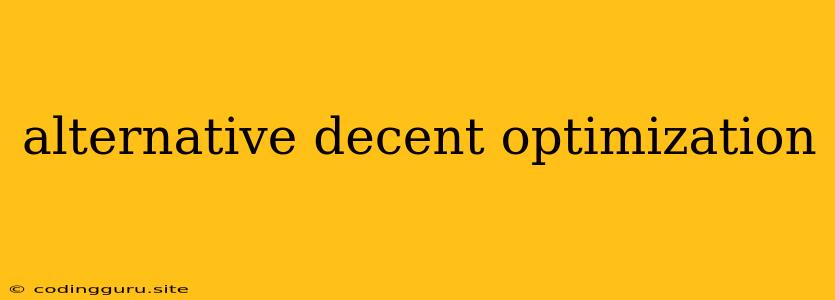Alternative and Decent Optimization: A Guide to Enhancing Performance
In the realm of technology, particularly in software development, optimization is a crucial aspect that determines the efficiency and performance of applications. While conventional optimization techniques have their merits, exploring alternative and decent approaches can lead to remarkable improvements.
Why Explore Alternatives?
Traditional optimization strategies often involve focusing on specific bottlenecks, such as CPU usage or memory consumption. However, these methods can sometimes overlook broader areas that could significantly impact performance. Alternative approaches provide a fresh perspective, considering various factors beyond the obvious.
What Makes an Optimization "Decent"?
A decent optimization is not merely about achieving the highest performance but also about ensuring that the improvements are sustainable and scalable. It involves:
- Understanding the Underlying Problem: Before implementing any optimization, it's essential to identify the root cause of the performance issue. This could involve profiling the application to pinpoint resource-intensive operations.
- Prioritizing Impactful Improvements: Focusing on the most significant performance bottlenecks yields the greatest impact. This involves analyzing the impact of potential optimizations on the overall system.
- Considering Trade-offs: Optimization often involves trade-offs between performance, resource consumption, and complexity. A decent approach carefully considers these trade-offs and selects solutions that provide the most value.
- Maintaining Code Quality: Optimization should not compromise the readability, maintainability, and scalability of the codebase. It's crucial to implement optimizations in a way that preserves the code's integrity.
Alternative and Decent Optimization Techniques
Let's delve into some alternative and decent optimization techniques that can significantly improve application performance:
1. Code Profiling and Analysis:
- Instrumentation Profiling: This technique involves instrumenting the code to collect data about its execution. This data can be used to identify bottlenecks, understand code execution paths, and measure the performance impact of different code sections.
- Sampling Profiling: Instead of instrumenting every line of code, sampling profiling takes snapshots of the application's execution at random intervals. This approach is less intrusive but may not provide as detailed information as instrumentation profiling.
- Static Code Analysis: This technique involves analyzing the code without actually executing it. Static code analyzers can detect potential performance issues, such as unused variables, unnecessary computations, and inefficient algorithms.
2. Algorithm and Data Structure Optimization:
- Choosing Efficient Algorithms: Selecting the right algorithm for a particular task can dramatically impact performance. For example, using a hash table for fast lookups or a binary search for efficient searching within a sorted array.
- Optimizing Data Structures: Choosing the appropriate data structure for the task at hand can significantly enhance performance. For instance, using a linked list for dynamic memory allocation or a tree for efficient searching and sorting.
3. Memory Management and Caching:
- Efficient Memory Allocation: Managing memory effectively can prevent fragmentation and improve performance. Techniques like object pooling and garbage collection can help optimize memory usage.
- Caching Data: Storing frequently accessed data in a cache can significantly reduce the need for repeated calculations or data retrieval, leading to substantial performance gains.
4. Parallel and Distributed Computing:
- Multithreading: Utilizing multiple threads to execute tasks concurrently can take advantage of multi-core processors and improve performance.
- Distributed Computing: Distributing tasks across multiple machines can enhance performance by parallelizing workloads and leveraging the resources of multiple systems.
5. Architectural Optimization:
- Microservices Architecture: Breaking down monolithic applications into smaller, independent services can improve scalability, maintainability, and performance.
- Event-Driven Architecture: Utilizing event-driven systems can improve responsiveness and scalability by decoupling components and allowing for asynchronous communication.
Examples of Alternative and Decent Optimization
- Using a Trie Data Structure: Instead of a traditional string matching algorithm, employing a Trie data structure can significantly improve search performance for large sets of strings.
- Implementing Lazy Evaluation: Evaluating expressions only when needed can save unnecessary computations and improve overall performance, particularly in complex calculations.
- Utilizing Asynchronous Operations: Performing I/O operations asynchronously can prevent blocking the main thread and improve responsiveness.
Conclusion
Alternative and decent optimization offers a powerful approach to enhancing application performance. By considering a broader range of techniques and prioritizing sustainable improvements, developers can achieve remarkable results. Remember to always analyze the underlying problem, prioritize impactful improvements, consider trade-offs, and maintain code quality. Exploring alternative and decent optimization strategies can lead to significantly faster, more efficient, and scalable applications.
